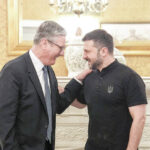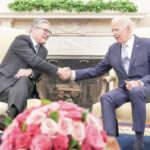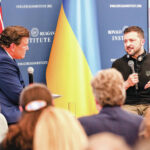US and allies aim to forge commitments to Ukraine that will endure



WASHINGTON — The United States and its NATO allies have agreed that Ukraine should have an “irreversible” path to membership in the alliance, enshrining the phrase in a document that was released Wednesday during the alliance’s summit in Washington.
While there is no consensus yet about Ukraine joining NATO, the strengthened language shows that there is movement in that direction. The United States was once deeply skeptical about whether Ukraine was ready to become a member, and while questions remain, more and more U.S. and European officials believe that the country will eventually be able to join.
ADVERTISING
“Ukraine’s future is in NATO,” members said in a communiqué, adding that “we will continue to support it on its irreversible path to full Euro-Atlantic integration, including NATO membership.”
The document does not lay out an exact timeline for membership, which the Ukrainians have wanted, but it says the allies will continue to support Ukraine’s progress on “democratic and security sector reforms.”
U.S. and allied officials negotiated the commitments to Ukraine with new urgency, given the uncertainty over whether President Joe Biden, a staunch opponent of Russia in its war, can win reelection this fall, according to officials in Washington.
The officials had said it was critical that leaders of the 32 member nations who have gathered in Washington this week used strong language to signal that Ukraine has a viable path to joining the alliance, even if it does not happen immediately because of the war.
They also said the leaders must agree to concrete steps to ensure the alliance is the main organizer of military and humanitarian aid to Ukraine rather than the United States.
Looming over the conversations is the specter of a second Donald Trump presidency. Trump has expressed admiration for Russian President Vladimir Putin, criticized Ukraine and expressed doubts about sending any additional U.S. military aid to the nation. And in his first term, Trump talked about withdrawing the United States from NATO.
Because of these concerns, officials and analysts said that “Trump-proofing” the alliance and aid to Ukraine was an important element of the talks this week. “Ukraine can and will stop Putin, especially with our full, collective support,” Biden said in a speech Tuesday night.
Beyond solidifying foundations that could endure into a Trump presidency, the leaders are also trying to head off criticism from President Volodymyr Zelenskyy of Ukraine, who last year accused the alliance of waffling on a promise to give his country membership.
But a more amicable version of Zelenskyy arrived in Washington on Tuesday. He expressed thanks for the support given to Ukraine so far while prodding the administration to continue relaxing its restrictions on the use of U.S. weapons in Russia and sending immediate aid.
“It’s time to step out of the shadows to make strong decisions to act and not wait for November,” he said in a speech, referring to the U.S. presidential election. “We must be strong and uncompromising all together.”
•••
UKRAINE’S PATH TO NATO MEMBERSHIP
The debate about the communiqué revolved around whether to say that Ukraine has an “irreversible” path to NATO membership and what conditions to attach to that.
The alliance grants membership only by unanimous consent, and U.S. and other officials have been wary of what Hungary might say. The country’s prime minister, Viktor Orban, visited Russia and China before arriving in Washington and is more sympathetic than other NATO leaders to Putin.
U.S. and allied officials say that in any case, a mutual defense clause in the NATO treaty makes it difficult to allow Ukraine in while it is at war. The alliance wants to avoid a direct war with Russia, a nuclear power.
Committing to More Aid
Jens Stoltenberg, secretary-general of NATO, urged top diplomats at an alliance meeting in Prague in May to commit to collectively giving Ukraine 100 billion euros (about $1.1 billion) in military aid over the next five years.
He could not get consensus. But officials agreed to give Ukraine “a minimum base-line funding” of 40 billion euros within the next year.
•••
INCREASING MEMBERS’ MILITARY SPENDING
There is another numbers concern: Trump has often criticized NATO members for not spending more on defense.
The allies agreed in 2014 to spend at least 2% of their economic output, or gross domestic product, on their militaries. At the time, only the U.S., Britain and Greece were meeting the goal.
During the 2018 NATO summit, Trump railed against allies for that failure and then surprised leaders by demanding an increase of the benchmark to 4%, a goal that would have been out of reach for many alliance members. He said the United States would “go its own way” in 2019 if military spending from other NATO countries did not rise.
Trump so upset NATO leaders that they abandoned plans to hold a 70th anniversary summit the next year in Washington, fearing he would ruin it.
Biden noted in his Tuesday speech that in 2020, when he was elected, only nine countries had reached the 2% goal. Now, 23 of the 32 member nations will spend at least that. “It’s remarkable progress,” he said.
•••
A NEW COMMAND
To guard against any future decline of the United States’ role in supporting Ukraine, the alliance is setting up a mission in Germany to coordinate assistance.
After Russia’s invasion in February 2022, the United States took the lead in organizing military aid. That assistance has been coordinated through the Ukraine Defense Contact Group, which is run by Defense Secretary Lloyd Austin and includes representatives from allied nations. While that group will continue, NATO is setting up a separate office in Germany to coordinate aid of all kinds to Ukraine.
•••
KEEPING ASIAN ALLIES CLOSE
Creating a tighter web between NATO and Asia-Pacific countries allied with the United States — Japan, South Korea, Australia and New Zealand — also helps hedge against any uncertainty that would arise from a second Trump term, Farkas said.
A U.S. president might find it harder to extricate the United States from commitments and partnerships if NATO and Asia-Pacific allies of the United States spoke with one voice on important issues, such as Russia or China.
© 2024 The New York Times Company







